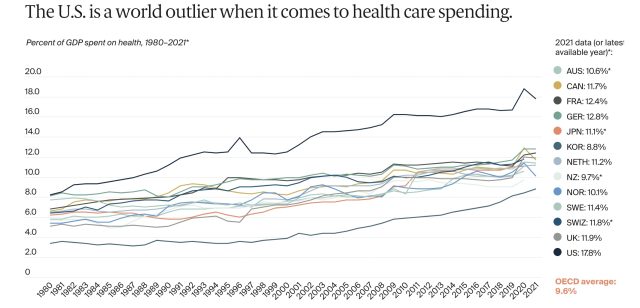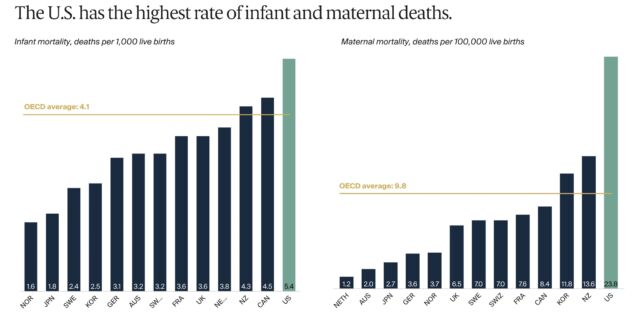

US still has the worst, most expensive health care of any high-income country
source link: https://arstechnica.com/science/2023/01/us-still-has-the-worst-most-expensive-health-care-of-any-high-income-country/
Go to the source link to view the article. You can view the picture content, updated content and better typesetting reading experience. If the link is broken, please click the button below to view the snapshot at that time.
Terrible —
US still has the worst, most expensive health care of any high-income country
US health care has lagged peers for years, and the pandemic made things worse.
Beth Mole - 1/31/2023, 9:18 PM

Americans spend an exorbitant amount of money on health care and have for years. As a country, the US spends more on health care than any other high-income country in the world—on the basis of both per-person costs and a share of gross domestic product. Yet, you wouldn't know it from looking at major health metrics in years past; the US has relatively abysmal health. And, if anything, the COVID-19 pandemic only exacerbated the US health care system's failures relative to its peers, according to a new analysis by the Commonwealth Fund.
Compared with other high-income peers, the US has the shortest life expectancy at birth, the highest rate of avoidable deaths, the highest rate of newborn deaths, the highest rate of maternal deaths, the highest rate of adults with multiple chronic conditions, and the highest rate of obesity, the new analysis found.
"Americans are living shorter, less healthy lives because our health system is not working as well as it could be," Munira Gunja, lead author of the analysis and a senior researcher for The Commonwealth Fund’s International Program in Health Policy and Practice Innovation, said in a press statement. "To catch up with other high-income countries, the administration and Congress would have to expand access to health care, act aggressively to control costs, and invest in health equity and social services we know can lead to a healthier population."
AdvertisementDying young
Overall, the analysis paints a grim picture of how much catching up the US has to do. In terms of life expectancy, the US has trailed its peers for years but took a nosedive during the pandemic, while other countries fared better. In 2020, the average life expectancy at birth in the US was 77 years, three years lower than the average for high-income countries. The next lowest life expectancy among high-income countries was from the UK, which had a 2020 life expectancy at birth of 80.4 years.
Provisional data for 2021 suggests US life expectancy fell nearly a full year further, from 77.0 years to 76.1 years. Relatedly, the US had the highest rate of deaths from COVID-19 in 2020 compared with its high-income peers and was among the lowest of its peers in rates of COVID-19 vaccination.
In a particularly shameful set of statistics, the US continues to have the highest infant and maternal mortality rates of any other high-income country. In 2020, there were 5.4 infant deaths per 1,000 live births in the US, while the average among high-income countries was 4.1 infant deaths. In Norway, there were 1.6 deaths per 1,000 live births. The health care system is also failing mothers. In 2020, there were 24 maternal deaths per 100,000 live births, about 2.5 times higher than the average for high-income countries. The country with the next highest maternal mortality rate was New Zealand with 13.6 per 100,000 live births.
With many US states now rapidly turning back the clock on reproductive rights and maternity care, the US's appallingly high rates of infant and maternal deaths are expected to worsen.
AdvertisementBeyond pregnancy, Americans are dying from other conditions that are treatable or preventable at a rate far higher than those seen in all other high-income countries. In 2020, 336 US deaths per 100,000 people were avoidable, while the average among high-income countries was just 225 deaths per 100,000. The rate of avoidable deaths has been rising in the US since 2015, the analysis notes.
Sicker
That tracks with the finding that Americans are more likely than their high-income-country peers to have multiple chronic conditions. In 2020, 30.4 percent of US adults said that they had previously been diagnosed with two or more chronic conditions in their life. Among other high-income countries, no more than a quarter of adults reported having two or more chronic conditions. America's high obesity rate may play into that discrepancy. The US has a higher obesity rate than any other high-income country. In fact, it's nearly two times higher than the average of its peers.
While Americans are dying young from avoidable conditions, they're also spending an exorbitant amount on health care. The US spent 17.8 percent of its GDP on health care in 2020, nearly twice as much as the average of 9.6 percent among high-income countries. On a per-person basis, it outspent its peers, paying nearly $12,000 per person via government insurance programs, private insurance coverage, and out-of-pocket costs. The country that came the closest to US spending was Germany, with a little over $7,000 per-person spending.
The data hints that these high prices are discouraging Americans from getting the care they need, potentially feeding into the country's high rates of chronic conditions and avoidable deaths. In the analysis, the US had among the lowest rate of doctor visits, with just four per year. The average was 5.7. The US also has one of the lowest rates of practicing physicians per 1,000 people—2.6 per 1,000, while the average is 3.7.
The US was the only high-income country in the analysis that does not guarantee health coverage. People in most other high-income countries have guaranteed health coverage with the option of buying supplemental private coverage.
This post has been updated to correct an error. The rate of practicing physicians was measured per 1,000 people, not 100,000.
Recommend
About Joyk
Aggregate valuable and interesting links.
Joyk means Joy of geeK

